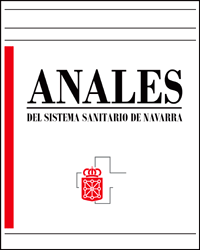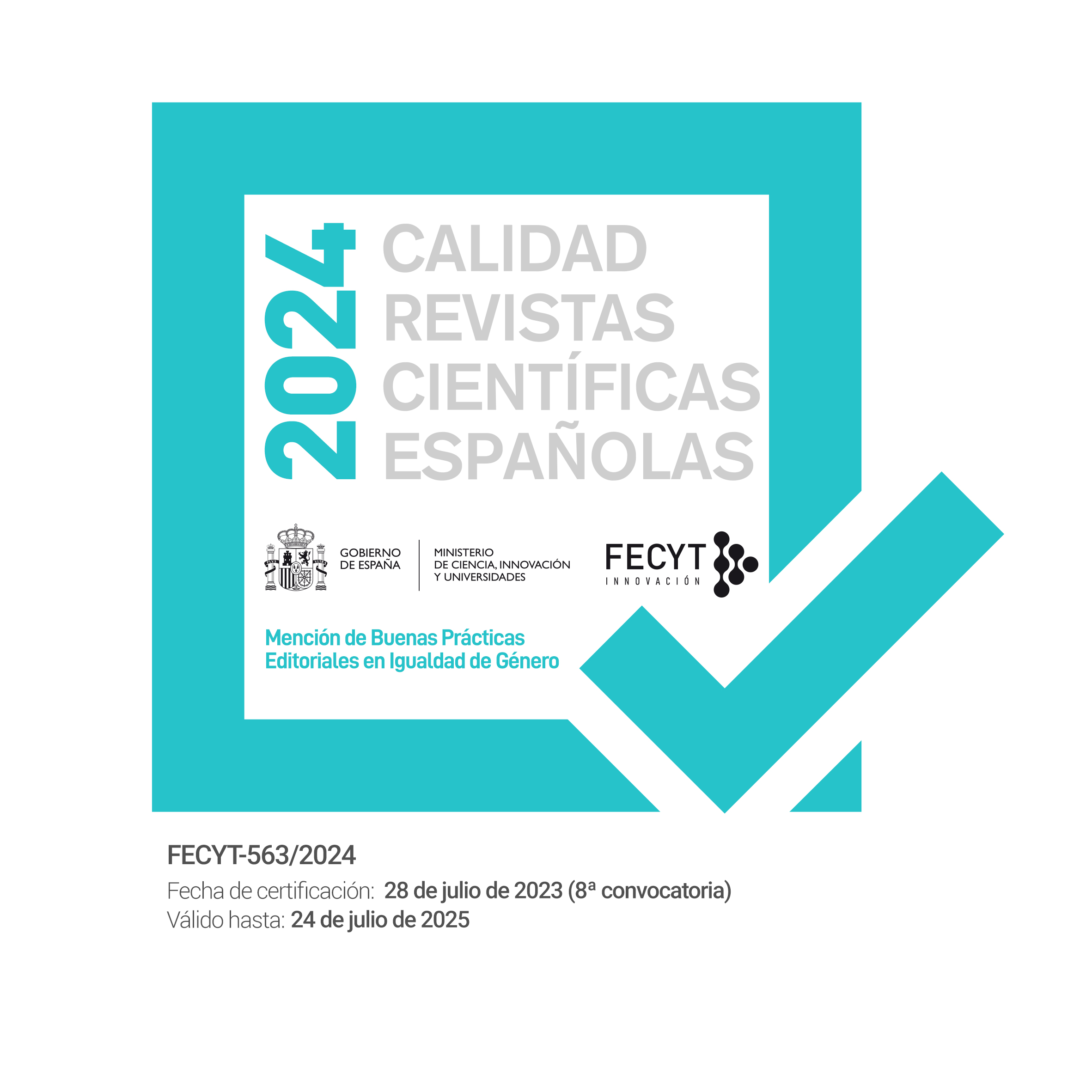Valores de referencia españoles para la versión reducida de la Escala de Autoeficacia para la Lactancia Materna BSES-SF
DOI:
https://doi.org/10.23938/ASSN.0337Palabras clave:
Lactancia Materna. Autoeficacia. Cuestionario. Valores de referencia.Resumen
Fundamento. Describir los valores de referencia para la versión española de la Escala de Autoeficacia para la Lactancia Materna en su versión reducida (BSES-SF), considerando las diferencias según la experiencia previa en lactancia y la paridad.
Metodología. Estudio transversal realizado en cinco hospitales de Alicante y uno de la Región de Murcia, en una muestra accidental de 949 mujeres que ofrecieron lactancia materna en el posparto, sin problemas médicos, propios o del recién nacido, que dificultaran la lactancia. Se obtuvieron datos sociodemográficos, obstétricos y sobre autoeficacia materna para la lactancia mediante la escala BSES-SF. Se calcularon datos de tendencia central, dispersión y percentiles de las puntuaciones de la escala BSES-SF para generar valores de referencia para toda la muestra y según la paridad y experiencia previa.
Resultados. El nivel de autoeficacia fue significativamente menor (p<0,001) entre las mujeres primíparas (media =47,67±11,03) o sin experiencia previa (media =47,30±11,18) que entre las multíparas (media =52,87±10,66) o con experiencia anterior (media =53,93±9,93). La puntuación de los percentiles P25 y P75 de la escala BSES-SF fue, respectivamente, para toda la muestra de 42 y 59; para las mujeres sin hijos o sin experiencia previos de 39 y 56; para madres con hijos de 46 y 61; y para las madres con experiencia previa de 47 y 62.
Conclusión. Los percentiles específicos obtenidos, según la paridad o la experiencia previa, pueden considerarse como valores de referencia para comparar el nivel de autoeficacia de un caso dado, evaluar intervenciones educativas y planificar intervenciones de apoyo durante el posparto.Descargas
Citas
1. Section on breastfeeding. Breastfeeding and the use of human milk. Pediatrics 2012; 129: e827-841.
https://doi.org/10.1542/peds.2011-3552
2. WHO, UNICEF. Global strategy for infant and young child feeding. Geneva: WHO, 2003.
3. Black RE, Allen LH, Bhutta ZA, Caulfield LE, de Onis M, Ezzati M et al. Maternal and child undernutrition study group. Maternal and child undernutrition: global and regional exposures and health consequences. Lancet 2008; 371: 243-260.
https://doi.org/10.1016/S0140-6736(07)61690-0
4. CALLEN J, PINELLI J. Incidence and duration of breastfeeding for term infants in Canada, United States, Europe, and Australia: a literature review. Birth 2004; 31: 285-292.
https://doi.org/10.1111/j.0730-7659.2004.00321.x
5. Dirección General de Salud Pública. Encuesta Nacional de Salud de España 2011/12. Madrid (España): Ministerio de Sanidad y Consumo
2013 [Cited 2013 Apr 29]. Disponible en: http://www.msc.es/estadEstudios/estadisticas/encuestaNacional/encuestaNac2011/encuestaResDetall2011.htm.
6. EU Project on Promotion of Breastfeeding in Europe. Protection, promotion and support of breastfeeding in Europe: a blueprint for action (revised). European Commission, Directorate Public Health and Risk Assessment, Luxembourg, 2008 [Cited 2014 Mar 04]. Available from: http://www.burlo.trieste.it/documenti/revisedblueprint07.pdf.
7. Ministerio de Sanidad y Política Social. Atención Hospitalaria al Parto. Estándares y Recomendaciones para Maternidades Hospitalarias. Madrid: Ministerio de Sanidad y Política Social; 2009 [Cited 2014 Mar 04]. Available from: http://www.msc.es/organizacion/sns/planCalidadSNS/docs/AHP.pdf
8. THULIER D, MERCER J. Variables associated with breastfeeding duration. J Obstet Gynecol Neonatal Nurs 2009; 38: 259-268.
https://doi.org/10.1111/j.1552-6909.2009.01021.x
9. HANNULA L, KAUNONEN M, TARKKA MT. A systematic review of professional support interventions for breastfeeding. J Clin Nurs 2008; 17: 1132-1143.
https://doi.org/10.1111/j.1365-2702.2007.02239.x
10. CATTANEO A, YNGVE A, KOLETZKO B, GUZMAN LR. Protection, promotion and support of breast-feeding in Europe: current situation. Public Health Nutr 2005; 8: 39-46.
https://doi.org/10.1079/PHN2005660
11. BELLINTXON M, ZARAGÜETA MC, ADRIÁN MC, LÓPEZ-DICASTILLO O. El comienzo de la lactancia: experiencias de las madres primerizas. An Sist Sanit Navar 2011; 34: 409-418.
https://doi.org/10.4321/S1137-66272011000300007
12. BLYTH RJ, CREEDY DK, DENNIS CL, MOYLE W, PRATT J, DE VRIES SM et al. Breastfeeding duration in an Australian population: the influence of modifiable antenatal factors. J Hum Lact 2004; 20: 30-38.
https://doi.org/10.1177/0890334403261109
13. IP WY, YEUNG LS, CHOI KC, CHAIR SY, DENNIS CL. Translation and validation of the Hong Kong Chinese version of the breastfeeding self-efficacy scale-short form. Res Nurs Health 2012; 35: 450-459.
https://doi.org/10.1002/nur.21493
14. OTSUKA K, DENNIS CL, TATSUOKA H, JIMBA M. The relationship between breastfeeding self-efficacy and perceived insufficient milk among Japanese mothers. J Obstet Gynecol Neonatal Nurs 2008; 37: 546-555.
https://doi.org/10.1111/j.1552-6909.2008.00277.x
15. GATTI L. Maternal perceptions of insufficient milk supply in breastfeeding. J Nurs Scholarsh 2008; 40: 355-363.
https://doi.org/10.1111/j.1547-5069.2008.00234.x
16. BANDURA A. Self-efficacy mechanism in human agency. Am Psychologist 1982; 37: 122-147.
https://doi.org/10.1037/0003-066X.37.2.122
17. DENNIS CL. The breastfeeding self-efficacy scale: psychometric assessment of the short form. J Obstet Gynecol Neonatal Nursing 2003; 32: 734-744.
https://doi.org/10.1177/0884217503258459
18. WUTKE K, DENNIS CL. The reliability and validity of the Polish version of the Breastfeeding Self-Efficacy Scale-Short Form: Translation and psychometric assessment. Int J Nurs Stud 2007; 44:1439-1446.
https://doi.org/10.1016/j.ijnurstu.2006.08.001
19. GREGORY A, PENROSE K, MORRISON C, DENNIS CL, MACARTHUR C. Psychometric properties of the Breastfeeding Self-Efficacy Scale-Short Form in an ethnically diverse U.K. sample. Public Health Nurs 2008; 25: 278-284.
https://doi.org/10.1111/j.1525-1446.2008.00705.x
20. ZUBARAN C, FORESTI, K, SCHUMACHER M, THORELL MR, AMORETTI A, MÜLLER L et al. The Portuguese version of the Breast feeding Self-Efficacy Scale-Short Form. J Hum Lact 2010; 26: 297-303.
https://doi.org/10.1177/0890334409359916
21. ALUS-TOKAT M, OKUMUŞ H, DENNIS CL. Translation and psychometric assessment of the Breast-feeding Self-Efficacy Scale-Short Form among pregnant and postnatal women in Turkey. Midwifery 2010; 26: 101-108.
https://doi.org/10.1016/j.midw.2008.04.002
22. MCCARTER-SPAULDING DE, DENNIS CL. Psychometric testing of the breastfeeding self-efficacy scale-short form in a sample of black women in the United States. Res Nurs Health 2010; 33: 111-119.
https://doi.org/10.1002/nur.20368
23. PAVICIC BOSNJAK A, RUMBOLDT M, STANOJEVIC M, DENNIS CL. Psychometric assessment of the Croatian version of the breastfeeding self-efficacy scale-short form. J Hum Lact 2012; 28: 565-569.
https://doi.org/10.1177/0890334412456240
24. OLIVER-ROIG A, D'ANGLADE-GONZÁLEZ ML, GARCÍA-GARCÍA B, SILVA-TUBIO JR, RICHART-MARTÍNEZ M, DENNIS CL. The Spanish version of the Breastfeeding Self-Efficacy Scale-Short Form: reliability and validity assessment. Int J Nurs Stud 2012; 49: 169-173.
https://doi.org/10.1016/j.ijnurstu.2011.08.005
25. NOEL-WEISS J, RUPP A, CRAGG B, BASSETT V, WOODEND AK. Randomized controlled trial to determine effects of prenatal breastfeeding workshop on maternal breastfeeding self-efficacy and breastfeeding duration. J Obstet Gynecol Neonatal Nurs 2006; 35: 616-624.
https://doi.org/10.1111/j.1552-6909.2006.00077.x
26. AWANO M, SHIMADA K. Development and evaluation of a self care program on breastfeeding in Japan: A quasi-experimental study. Int Breastfeed J 2010; 5: 9.
https://doi.org/10.1186/1746-4358-5-9
27. FLAHERMAN VJ, GAY B, SCOTT C, AVINS A, LEE KA, NEWMAN TB. Randomised trial comparing hand expression with breast pumping for mothers of term newborns feeding poorly. Arch Dis Child Fetal Neonatal Ed 2012; 97: 18-23.
https://doi.org/10.1136/adc.2010.209213
28. LLOPIS-RABOUT-COUDRAY M, LÓPEZ-OSUNA C, DURÁ-RAYO M, RICHART-MARTÍNEZ M, OLIVER-ROIG A. Fiabilidad y validez de la versión española de una escala de autoeficacia en la lactancia materna. Matronas Prof 2011; 12: 3-8.
29. MUÑIZ J, ELOSUA P, HAMBLETON RK. International Test Commission Guidelines for test translation and adaptation: second edition. Psicothema 2013; 25: 151-157.
https://doi.org/10.7334/psicothema2013.24
30. RÍO I, LUQUE A, CASTELLÓ-PASTOR A, SANDÍN-VÁZQUEZ MDEL V, LARRAZ R, BARONA C, et al. Uneven chances of breastfeeding in Spain. Int Breastfeed J 2012; 7: 22.
https://doi.org/10.1186/1746-4358-7-22
31. SPIELBERGER CD, GORSUCH RL, LUSHENE RE. STAI, Manual para el Cuestionario de Ansiedad Estado-Rasgo. 7ª Ed. Madrid: Tea Ediciones; 2008.
Publicado
Cómo citar
Número
Sección
Licencia

Esta obra está bajo una licencia internacional Creative Commons Atribución-CompartirIgual 4.0.
La revista Anales del Sistema Sanitario de Navarra es publicada por el Departamento de Salud del Gobierno de Navarra (España), quien conserva los derechos patrimoniales (copyright ) sobre el artículo publicado y favorece y permite la difusión del mismo bajo licencia Creative Commons Reconocimiento-CompartirIgual 4.0 Internacional (CC BY-SA 4.0). Esta licencia permite copiar, usar, difundir, transmitir y exponer públicamente el artículo, siempre que siempre que se cite la autoría y la publicación inicial en Anales del Sistema Sanitario de Navarra, y se distinga la existencia de esta licencia de uso.








